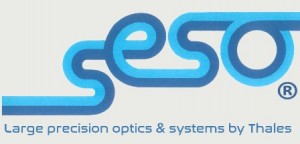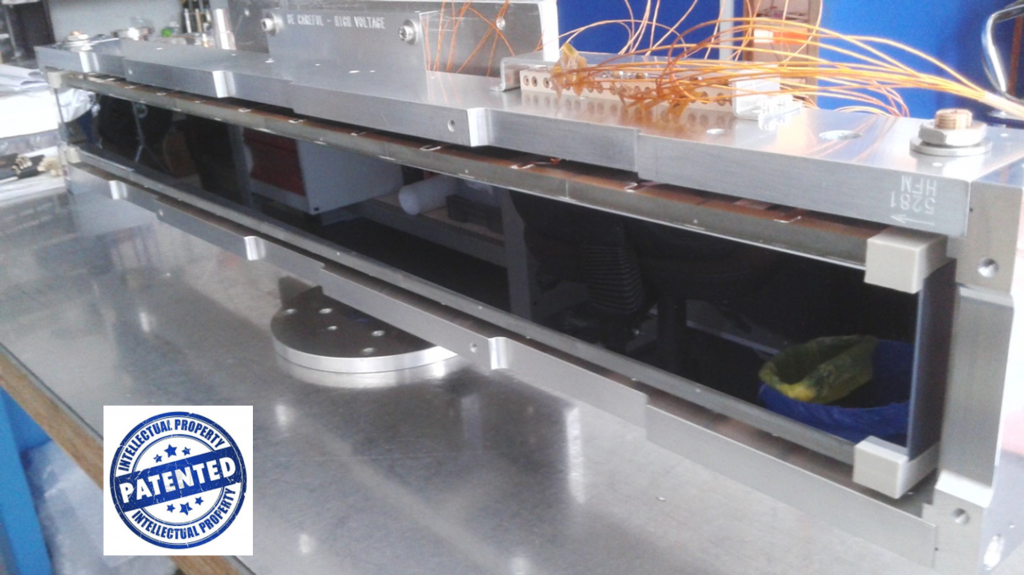Bimorph state of the art: 100nrad and 0.5nm rms
During the last year THALES SESO manufactured and delivered more than 10 integrated elliptical bimorphs for Brookhaven National Laboratory (USA), the Photon Factory (Japan), Diamond Light Source (UK). The mirror system have been designed, realized and set-up with slope errors between 100 and 150 nrads and shape errors of 0.5 to 1 nm RMS over the full lengths (400-1000 mm). These are elliptical mirrors can be operated as focusing device over extremely wide range of focal distances (from q_min=0.5 m to q_max=25 m). A photo of one of these mirrors is shown in the following figure (length 800mm).
Thales SESO the Pioneer in Bimorph mirror technology
With the patented first and second generation bimorphs and more than 80 bimorphs already delivered to various synchrotron facilities worldwide, TSESO has been pioneering this field and is keeping a leading role in the fabrication of a very compact adaptive x-ray mirror based on the properties of piezoelectric ceramics.
Once properly shaped they can be used to focus, collimate or for beam shaping in a variety of application. In contrast to traditional mirrors with mechanical benders or fixed curvature mirrors, where the user gets only few degree of freedom to adjust the mirror radius and coma aberrations, bimorph mirrors come with many degree of freedom (typically from 8 to 32) thus allowing to suppress higher order aberrations and middle-high spatial frequencies with periods larger than 20 mm.
Bimorph mirrors are becoming a common optical element on synchrotron beamlines in various synchrotron radiation facilities worldwide and more recently free-electron lasers (XFEL).
Nevertheless most of this potential has not been fully exploited and a number of tools are being prepared to realize a short feedback between mirror shaping and online metrology. A collaboration with the optics group of the Diamond Light Source is currently tackling this aspect.
Concept of Bimorph mirrors

Left: Schematic of 2nd generation bimorph mirror from Thales-SESO, showing piezo ceramics glued to the side faces of the monolithic substrate. Right: Double-face bimorph designed to acts either as a collimator or focusing device
The full potential of Bimorphs is still unexplored
Modern synchrotron radiation sources (3rd generation and Free Electron Lasers) need very high quality optics to exploit the full power and preserve the coherence of the radiation.
The target specifications for such mirrors are the following:
– sub-nm surface figure errors
– Roughness at the atomic scale and
– Slope errors below 150 nrad over mirror length (up to 1.5 m)
Ideally the polishing should be realized in a deterministic fashion anticipating all the effect that may deteriorate the mirror performance in its final use such as gravity, mirror holding and heat load. The latter point is particularly important for high power sources such as ERL, XFEL and upgraded synchrotron in progress.
Since all these effect cannot be fully anticipated, the bimorph X-ray mirror represents a valuable solution and has many competitive advantages for state of the arts super-polished optics.
Even a perfect mirror will present defects once it is integrated in its final system and in particular during beamline operation: a number of effects appear under irradiation that would lead to additional wavefront distortion due to the optics placed upstream, the continuously varying intensity of the source and thermal drifts. The bimorph mirror is the only available optic which can adapt its shape to correct all these types of systematic errors dynamically and locally along the mirror coordinate.
This solution represent the future of X ray optics thanks to its active correction capabilities.



